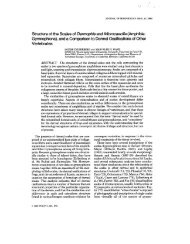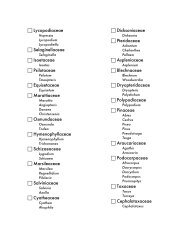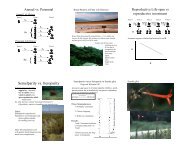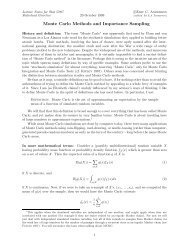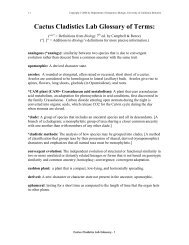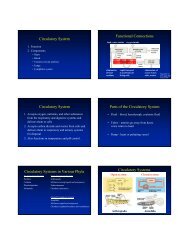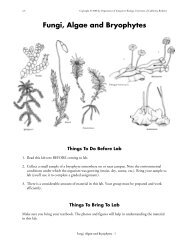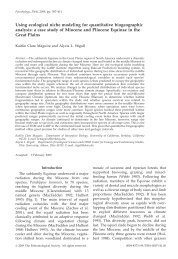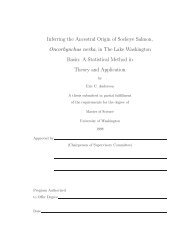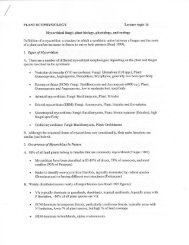Introduction to Cladistic Analysis - Integrative Biology - University of ...
Introduction to Cladistic Analysis - Integrative Biology - University of ...
Introduction to Cladistic Analysis - Integrative Biology - University of ...
Create successful ePaper yourself
Turn your PDF publications into a flip-book with our unique Google optimized e-Paper software.
Copyright © 2009 by Department <strong>of</strong> <strong>Integrative</strong> <strong>Biology</strong>, <strong>University</strong> <strong>of</strong> California-Berkeley<br />
Table A. Morphological characters <strong>of</strong> six taxa. An “x” indicates that the character is present while a “y”<br />
indicates the character is absent.<br />
deuteros<strong>to</strong>me no<strong>to</strong>chord vertebrae jaws skull swimbladder enamel four<br />
development<br />
or lung<br />
true<br />
limbs<br />
tunicate x x y y y y y y<br />
lamprey x x x y x y y y<br />
Cladoselache † x x x x x y y y<br />
trout x x x x x x y y<br />
lungfish x x x x x x x y<br />
frog x x x x x x x x<br />
Plesiomorphies and apomorphies<br />
A plesiomorphy is an "ancestral", "less specialized", or "primitive" character. An<br />
apomorphy is a "derived", "specialized", or "advanced" character. Every taxon possesses a<br />
mixture <strong>of</strong> plesiomorphies and apomorphies.<br />
At some point in time during the evolution <strong>of</strong> the taxa pictured in Figure A, vertebrae<br />
(serially arranged skeletal units that enclose the nerve cord) came in<strong>to</strong> existence.<br />
"Absence <strong>of</strong> vertebrae" is one character state. "Presence <strong>of</strong> vertebrae" is another character<br />
state. These two character states are parts <strong>of</strong> a "transformation series" (the former was<br />
transformed, or evolved, in<strong>to</strong> the latter). With reference <strong>to</strong> the six taxa shown in Figure A,<br />
the absence <strong>of</strong> vertebrae is a plesiomorphic character, and the presence <strong>of</strong> vertebrae is an<br />
apomorphic character. For these six taxa, having vertebrae represents an evolutionary<br />
advancement.<br />
Distinguishing plesiomorphies from apomorphies is tricky business. Luckily, Hennig<br />
developed a method called outgroup comparison for partitioning characters in<strong>to</strong> these two<br />
basic types.<br />
Outgroup comparison<br />
Outgroup comparison is a means <strong>of</strong> determining which character in a transformation series<br />
is a plesiomorphy and which is an apomorphy. IT IS IMPORTANT TO REMEMBER THAT<br />
THE OUTGROUP DEFINES THE CHARACTER STATE. FOR OUR PURPOSES, WE<br />
DEFINE THE OUTGROUP AS PLESIOMORPHIC. But please appreciate the selection <strong>of</strong><br />
the proper outgroup usually requires a good deal <strong>of</strong> effort.<br />
<strong>Introduction</strong> <strong>to</strong> <strong>Cladistic</strong> <strong>Analysis</strong> - 8



